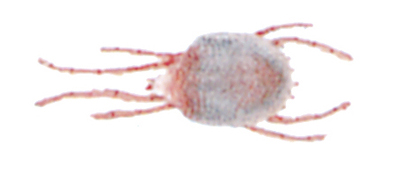(Latin: sp. Bryobia)

These are very tiny mites which sometimes occur in large numbers on the walls and windows of houses with gardens, particularly if the lawn comes close up to the walls. Their red colour often gives rise to the idea that they suck blood, but in fact they live by sucking the juices of green plants. During the course of their life they wander back and forth between the plants and suitable retreats on trees, rock or walls, where they lay eggs, moult and also spend the winter.
Normally they overwinter as eggs, and show no activity until the spring when the temperature rises about 7° C and the eggs start to hatch. They do not become really active until the temperature is considerably higher, and are often seen on walls facing south or west.
When the eggs hatch, the young mites immediately move down to the grass to feed, but return to their hiding-place on the wall to moult after their first feeding period. This process is repeated three times, until the mites have become adult. The adult females also migrate, their feeding periods alternating with egg laying periods. In this way the mites are sometimes seen indoors in large numbers, particularly in the spring, entering through cracks and crevices, and especially through the windows.
Males are never seen so the species must breed parthogenetically.
These mites cause absolutely no damage in the house and they very quickly die in the dry climate. They are completely dependent upon the presence of plants on which they can feed. Normally they are only seen in houses where the lawn goes right up to the walls, so the most rational method of control is to create a break between lawn and wall. This can easily be done by having a strip of gravel or stone chips ½ – 1 m wide.




